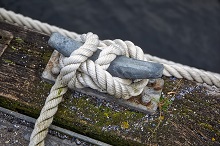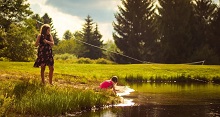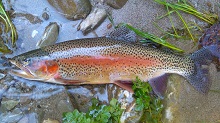Largemouth Bass Genetics: Vulnerability of being caught is a Heritable Trait
Canadian Angling.com Researchers at the University of Illinois recently concluded an experiment on largemouth bass lasting 20 years that found that vulnerability of being caught by fisherman is a heritable trait. The researchers used a resident population in Ridge Lake (Charleston). Fishing was restricted with fishermen having reserved fishing times allocated and all fish were placed in a live well. The fish were then recorded and tagged. They then were released.
“We kept track over four years of all of the angling that went on, and we have a total record – there were thousands of captures,” said David Philipp, ecology and conservation researcher at U of I. “Many fish were caught more than once. One fish was caught three times in the first two days, and another was caught 16 times in one year.”
The pond was drained after 4 years and the 1,700 were collected. “Interestingly, about 200 of those fish had never been caught, even though they had been in the lake the entire four years,” Philipp said.
The fish were then segregated into Low Vulnerability (LV) parents and produced a line of LV generation at the research ponds. They also produced a strain of High Vulnerability (HV) parents (caught 4 times or more) producing a HV generation. They were then marked and raised until they were large enough. “Controlled fishing experiments clearly showed that the HV offspring were more vulnerable to angling than the LV offspring,” said Philipp. This was repeated over generations for the 20 year test.
“As we had predicted, vulnerability was a heritable trait,” he said. Philipp found that vulnerability grew even larger with each generation.
“Most of the selection is occurring on the LV fish – that is, for the most part, the process is making that line of fish less vulnerable to angling. We actually saw only a small increase in angling vulnerability in the HV line,” Philipp said.
In early May or when the temperature of the water is about 60’F., the male builds the nest, a circular depression, six inches deep and two to four feet wide, in more or less sheltered areas on sand, gravel, clay or mud bottom, or on the roots of vegetation, in water up to three feet in depth. The female bass lay the eggs the male fertilize them, and the female leaves the nest. Hatching time depends upon the temperature of the water but it averages five to ten days. The male bass protect the nest and watch over the fry for up to 10 days before they become free swimming. They also protect the fry for up to 3 weeks from predators.
Philipp explained that “In the wild, the more vulnerable fish are being preferentially harvested, and as a result the bass population is being directionally selected to become less vulnerable. We selected over three generations, but in the wild the selection is occurring in every generation.
“We’ve known for 50 years that commercial fishing exerts selection on wild populations,” he said. “We take the biggest fish, and that has changed life histories and growth patterns in many populations of commercially harvested species. Because there is no commercial fishing for bass, we were assessing the evolutionary impacts of recreational fishing.”
He explained that if bass are taken off their spawning beds during the crucial 3 weeks of spawning, it could have serious consequences for the fry. Predators would quickly attack and eat the fry, thereby reducing the numbers of the next generation. Catch and release during this crucial time does have serious consequences to the fry.
Philipp recommends “There should be no harvesting bass during the reproductive period. That makes sense for all wildlife populations. You don’t remove the adults during reproduction.
“One of the big issues for concern is the explosion of tournaments. Lots of bass tournaments are held during the springtime because there are lots of big fish available. In tournaments you put fish into live wells, and yes, they’re released, but they could be held for up to 8 hours first. They’re brought back to the dock, miles from their nest. So, basically, if a fish is caught in a tournament and brought into the boat and put into a live well, his nest is destroyed.”
He recommended that if fishing tournaments were held during the spawning season, then regulations should require that there be immediate catch-and-release, eliminating the use of tournament weigh-ins.
In Illinois, the bass reproduction period is from about April 1 through June 15. Philipp urges that fisheries managers change the regulations in the lakes to protect spawning grounds from fishing during this critical time and change to catch and release in the rest of the lake during this time. This way, fishermen could help protect the long-term future of the resource without completely restricting fishing. In Ontario, fisheries managers from the MNR have realized this problem and as a result the fishing season for bass do not open until later in June when the males have left the nest.
“The potential for angling to have long-term evolutionary impacts on bass populations is real. If we truly want to protect this valuable resource into the future, then we need to understand that and adjust our management strategies,” Philipp said.
The University of Illinois research team included Steven Cooke, Julie Claussen, Jeffrey Koppelman, Cory Suski, and Dale Burkett.



